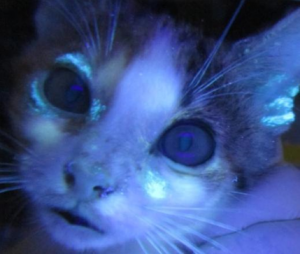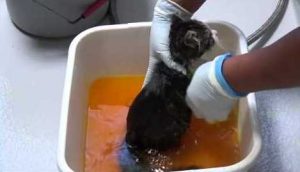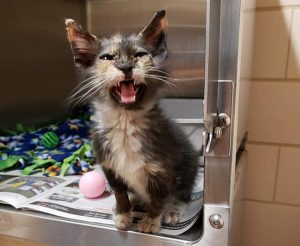Module 4: Healthcare practices for common contagious infectious diseases
Ringworm Treatment

Ringworm is a treatable and curable disease. Treatment shortens the course of disease and time to cure to 4 to 6 weeks. Successful treatment requires concurrent use of systemic oral antifungals and topical disinfection of the hair coat.
Topical therapy with lime sulfur dips is NOT optional. Applying lime sulfur (8 oz/gallon) twice weekly decreases shedding of infective material, kills spores, helps prevent new lesions, and decreases environmental contamination. Lime sulfur dips also prevent infection transmission between littermate kittens housed together. Kittens diagnosed with ringworm do not have to be separated from their in-contact littermates for treatment.

Based on shelter studies, all kittens in the litter can be treated twice weekly with lime sulfur to prevent ringworm infection. Lime sulfur contributes to faster resolution of disease compared to other topical treatments such as miconazole/chlorhexidine shampoo or Accel shampoo.
Systemic therapy with antifungals eradicates infection in the hair follicle and is also NOT optional. Itraconazole (non-compounded) and terbinafine are the most effective and safe treatments. Compounded itraconazole should not be used due to poor bioavailability. The veterinary brand of itraconazole suspension (Itrafungol) is preferred and the dose is 5 mg/kg PO once daily for 21 days for best outcome. Terbinafine at 30-40 mg/kg PO SID X 21 days can also be used.
Infected patients should be treated until mycological and clinical cure are achieved. Clinical cure commonly precedes mycological cure. In one study where 58 shelter cats with ringworm were treated with itraconazole for 21 days and twice weekly lime sulfur dips, the mean time to mycological cure was 18 days and all cats were cured by day 49. In another study where 85 shelter cats with ringworm were treated with terbinafine for 21 days and twice weekly lime sulfur dips, the mean time to mycological cure was 23 days. According to the 2017 WSAVA Guidelines for Diagnosis and Treatment of Dermatophytosis and a 2020 Dermatophytosis article, mycological cure is defined as the first negative DTM fungal culture for cats with resolved skin lesions and no other illnesses. For cats with other concurrent clinical conditions (e.g., URI), fungal cultures are not repeated until resolution of these conditions as well as the skin lesions. At this point, two consecutive negative fungal cultures are required for mycological cure.
The length of time kittens spend in “ringworm isolation” for treatment directly affects welfare and social skills, especially when treatment occurs during the critical socialization period of 3 to 8 weeks of age. Double-compartment housing and daily enrichment during ringworm isolation are musts. If a shelter can’t house cats in a manner that provides good welfare, cats should be sent to foster care or to another facility that can provide good welfare.

Dr. Wright developed a protocol, checklist, and flowchart to assist her staff in diagnosis and treatment of feline ringworm. She also created a lime sulfur dip protocol and a dosing table for Itrafungol based on body weight.

